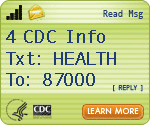Content on this page was developed during the 2009-2010 H1N1 pandemic and has not been updated.
- The H1N1 virus that caused that pandemic is now a regular human flu virus and continues to circulate seasonally worldwide.
- The English language content on this website is being archived for historic and reference purposes only.
- For current, updated information on seasonal flu, including information about H1N1, see the CDC Seasonal Flu website.
H1N1 Flu (Swine Flu): General Information
- About 2009 H1N1 Flu
- 2009 H1N1 Flu & You
- Information about the 2009 H1N1 Virus
- People at High Risk for Developing Related Complications
- Symptoms
- Emergency Warning Signs
- What To Do if You Get Sick
- Caring for Someone Sick at Home Dec 5
- How Flu Germs Spread
- 2009 H1N1 Vaccine: Q & A
- Testing for Flu: Q&A
- Treatment (Antiviral Drugs)
- Tips to Prevent Fluid Loss (Dehydration)
- Check for Fluid Loss
- When to Get Medical Help for Fluid Loss
- Treat Fever
- Treat Dry Cough
- Treat Other Flu Symptoms (Sore throat, chills, aches, pains, congestion, stomach problems)
- Facemask & Respirator Use
- Emergency Use Authorization (EUA) of Medical Products and Devices
- In The News: Questions & answers highlighted in the news
- Watch Flu Videos
- Audio & Video Resources
- Social Media
- 2009 H1N1 Flu: Free Resources
- Information for Specific Groups
- Background Information on Influenza in Pigs
See Also
Get email updates
To receive weekly email updates about this site, enter your email address:
Contact Us:
- Centers for Disease Control and Prevention
1600 Clifton Rd
Atlanta, GA 30333 - 800-CDC-INFO
(800-232-4636)
TTY: (888) 232-6348 - Contact CDC-INFO




